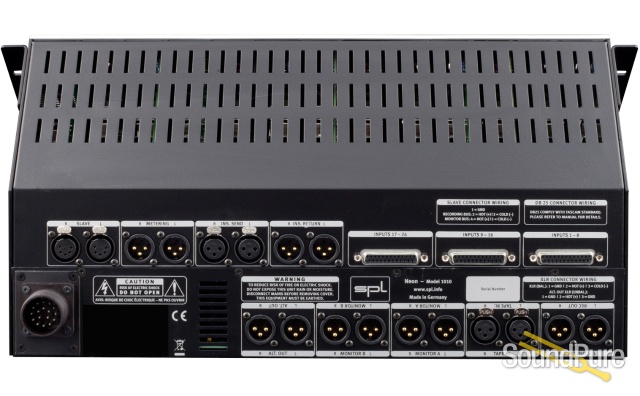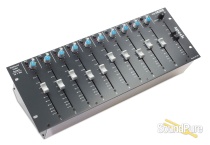-
Call Us Toll Free888-528-9703
-
Local/International (+1)919-682-5552
- Call Us! Toll Free! 888-528-9703
- Local / International (+1) 919-682-5552

SPL Neos 24 ch. Summing and Monitoring Console From SPL
Get your hands dirty in your next mix with this rackmount console from SPL!
Manufacturer's Description from SPL
The Neos is the first summing and monitoring console based on our proprietary 120V Rail technology. The basic concept behind it was to combine essential summing capabilities, including faders and panorama controls, with a complete and practical monitoring section — all in a compact design. Accordingly, it fulfills the highest expectations regarding sound quality in mixing and monitoring situations.
Thus, the Neos was conceived with sound engineers that set great importance on artistic and musical production in mind and whose workflow does not rely primarily on undo and preset options. Nevertheless, the compact Neos can integrate seamlessly in computer-based environments providing the characteristic high-quality sound and handling of analog devices.
- Ultimate mix and monitoring quality in 120V Rail technology
- 24 channel summing console with faders and panorama controls
- Compact design: 19"/7U
- Cascadable
- Ideal for DAW-based studios with emphasis on audio quality
- Input path with 100-mm ALPS faders, Pan controls, Mono, Cut, Solo, and “To Monitor Only” push buttons, signal LEDs
- Master path with 100-mm ALPS faders, Inserts, Bend function (Limiting)
- Comprehensive monitoring section with Volume control, Tape Mix (DAW return), as well as Mute, Dim and Mono push buttons
- Input: three eight-channel DB25 connectors (balanced, TASCAM standard); balanced XLR connectors: Slave, Insert Return, Tape Return
- Output connectors (balanced XLR): Recording Out, Monitor A and Monitor B,
- Output connectors (unbalanced XLR): Alternative Out, Insert Send, Metering
- Unique 120-volt operating voltage. In comparison with common production mixers, the Neos mixing and monitoring console uses four times as much operating voltage. A higher voltage results in better performance: over 30 dB of headroom at the input, more than 122 dB of dynamic range, 92 dB signal-to-noise ratio over all channels.
- All selected components for each unit are matched at the pre-production stage
- Important switching functions are performed via sealed relays
- Oversized signal traces, generous PCB layout for greater trace separation, star ground scheme, linear power supply
- Made in Germany
Fundamental research
Shortly after the turn of the millennium, SPL laid down new foundations for the improvement of analog audio signal processing. Thanks to new components, circuitries and manufacturing methods, we were able to increase the operating voltage enormously.
Up to then, average operating voltage ranged form 30 to 36 volts (+/- 15 or 18 volts, considering that voltage supply is symmetrical). Maximum operating voltages reached 60 volts (+/- 30 volts). At the core of our new technology are the handmade OP-amps that operate at 120 volts (+/- 60 volts), which means that we have in fact doubled the highest levels ever reached until then.
Next-Generation Analog
The first products to integrate the 120-volt technology were exclusive, handmade custom solutions for major mastering studios. At the time, music production had already been uprooted by digital technology and the changes it brought with itself in terms of outfitting and workflow in music studios. Coincidentally, a new „mastering“ sector had already been established — both in terms of the actual process and the gear in studios. If traditional recording and mixing studios were on their way to digitalization, the most sophisticated mastering studios were and have always been keen on analog technology, including high-quality signal processors that can still make a difference compared to the widely available software solutions. But also technically demanding requirements such as superior sounding and designed switching and monitoring consoles were among the products we were able to offer. While analog technology was being heralded as dead, SPL was decisively going in the opposite direction: we were able to deliver analog products of the highest quality whose performance surpassed all previous specifications — regardless of whether it was in the analog or digital realm.
Why is a high operating voltage so important?
If we consider that the basis of every circuit is directly related to a voltage/performance ratio, the operating voltage is crucial for the performance of any circuit. Given that audio technology is conceived to translate sound into voltage, doubling the formerly highest operating voltage available results in a great improvement, specially with regard to signal dynamics and the way they are processed. Technically speaking, a wider dynamic range also means that the gap between the actual signal and other undesired signals, such as noise and distortion, is larger — in the case of the Neos console, for example, this results in not hearing any noises at all, regardless of the situation.
Highest performance for ultimate sound quality
Our measurements reveal the improvements the 120-volt technology offers in comparison to standard solutions. All these advantages are due to the oversized signal traces, the rigorous selection of every single element and, of course, the handmade components that contain no unnecessary audio processing parts (which are very common in mass-produced operation amplifiers). But the technical specifications and design say very little about the actual sound of an audio equipment. At the end of the day, an audio device has to prove itself in use in the hands of sound engineers and musicians. We can state with great satisfaction that our solution not only prevailed — ever since their introduction, our 120-volt products have passed all tests and proven worthy of the best. Now the Neos console represents a solution that transfers unsurpassed performance into ultimate sound quality.
Integration and wiring examples
With a 24-channel interface and DB 25 connectors in TASCAM standard, wiring is almost too easy: connection is given and channel assignment follows the DAW setup.
The following examples cover a bit more complex scenarios that may yield some inspiration for individual solutions.
Three eight-channel converters
A common way to feed the 24 channels of the Neos would be to use three eight-channel D/A converters. As a rule, one converter is defined as the main converter and the two others are connected in chain. As long as the converters have the same DB25 connectors the connection is straight forward and the channel assignment corresponds to the one in the DAW’s setup.
A high-quality two-channel converter might the best option to record the signal of the Neos’ Rec. Out. The A/D stage could also be integrated through the S/PDIF inputs of the main converter. The recorded signal can be routed to the two-channel converter through the S/PDIF outputs of the main converter, whose D/A output would then be connected to the Tape Return of the Neos.
Converters with separate outputs
If the analog outputs of the converter are available as separate XLR and jack connectors, a clever channel assignment could save converter channels. Typical sessions have usually four mono channels (vocals, snare, kick, and bass) while the rest of the elements are available as stereo stems in the DAW (keyboards, guitars, backing vocals, overheads, toms, etc.). In this scenario you can make the final mixdown with the Neos. Nevertheless, do take into consideration that the more channels available for a production, the better.
Here is an example of such a session: once again we have three eight-channel converters, however this time they have separate outputs connected via eight XLR/jack-to-D25 snake cables. In the DAW, route the four mono channels to outputs 5, 6, 7, and 8 of the first converter. Afterwards, connect the converter outputs with the Neos DB25 inputs 1, 3, 5, and 7. That way, the mono signals are now controlled by the first faders of the Neos — and considering that the input paths are stereo, whenever you use mono signals one of the channels is free (in this example, DB25 outputs 2, 4, 6, and 8). All other stereo stems from the DAW should be routed to the Neos through the two other converters. On the first converter you still have four output channels left, which you can use for the Tape Return input of the Neos and a headphones mix.

About Manufacturer
Sound Performance Labs! Full Range of Analog, Tube, and Digital rack gear with an innovative twist. With their most famous transient designer product, SPL has quickly become a household name in both the recording and live sound arenas.
Specifications
Inputs & Outputs
- Electronically balanced instrumentation amplifiers
- Sockets: Inputs DB25/TASCAM, XLR; Outputs: XLR
- Input Impedance: 10kOhm balanced; 20kOhm unbalanced
- Output Impedance: 75Ohm balanced; 75Ohm unbalanced
- Nominal Input Level: +4dBu
- Maximum Input Level: › +30dBu (30dBu = limit of measuring equipment)
- Maximum Output Level: › 24dBu
Measurements
- Frequency Range (-3dB): 10Hz to ›200kHz
- Phase 1kHz: 0°, 10kHz: -4,5°, 20kHz: -8.30°
- Common Mode Rejection Ratio: › 60dB (Rec. Out, Insert Send, Monitor A/B)
Total Harmonic Distortion
- 10Hz Rec. Out: 0.0011%, Insert Send: 0.0011%, Monitor A/B: 0.0016%
- 100Hz Rec. Out: 0,00060%, Insert Send: 0.0009%, Monitor A/B: 0.0016%
- 1000Hz Rec. Out: 0.00090%, Insert Send: 0.0013%, Monitor A/B: 0.0020%
- 5000Hz Rec. Out: 0.0032%, Insert Send: 0.003%, Monitor A/B: 0.004%
- 10kHz Rec. Out: 0.0028%, Insert Send: 0.0018%, Monitor A/B: 0.0027%
- 22kHz Rec. Out: 0.00054%, Insert Send: 0.00050%, Monitor A/B: 0.0005%
(Generator output 24dBu, inputs terminated with 40dBu)
Signal to Noise Ratio (all channels)
- Rec. Out: 92dBu
- Insert Send 92dBu
- Monitor A/B: 88dB
(A-weighted, 22Hz - 22kHz, inputs terminated with 40dBu)
Dynamic range: › 122dB
Power Supply
- Linear power supply with toroidal transformer
- Operational Voltage : +/- 60Volts (120 Volts)
- Power Consumption (Standby, 230 Volts/50Hz): 0.420A, 75W, 97.8VA
- Fuses: 230V AC/50Hz: 315 mA; 115V AC/60Hz: 630 mA
- Voltage Selector: 115V/230V
Dimensions and Weight
- Front panel including rack brackets: 19"/7U (483 x 310 mm)
- Front panel without rack brackets: 440mm
- Housing (W x H x D): 483 x 235 x 330mm, depth incl. sockets: 355mm
- Weight: 14.1kg/ca. 31.08lbs
- External Power Supply: W x H x D 154 x 67 x 236mm, weight: 3kg/6.61lbs
0 dBu = 0.775 V. All measurements at unity gain.
Specifications are subject to change without notice.













